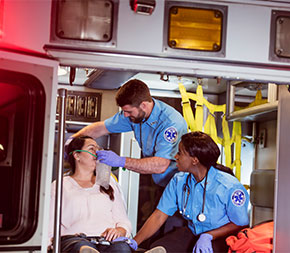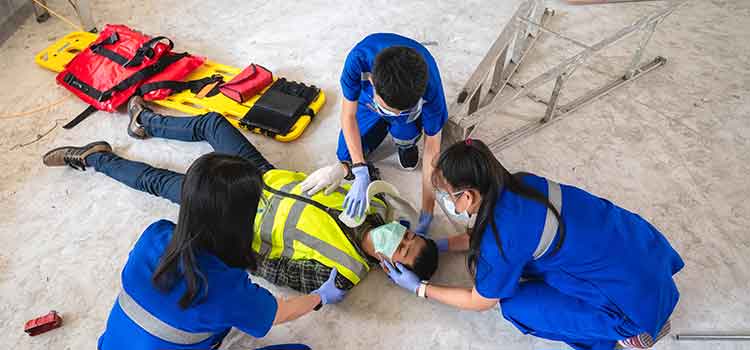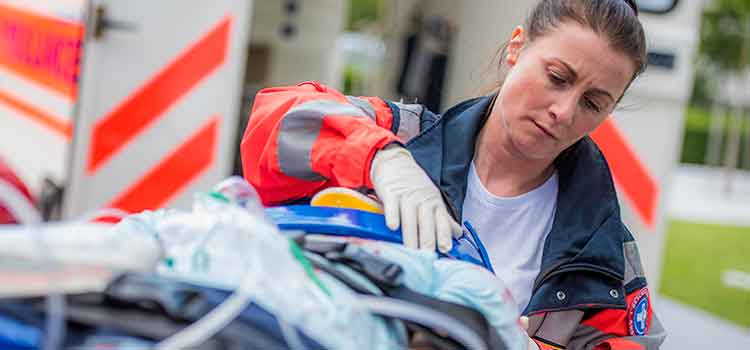In this Article

EMT Training Overview
What Is an EMT?
Every year there are more than 42,000 people in America die in a car crash says the NHTSA. That might sound like a large number, but it’s just a tiny fraction of the number of Americans cared for by emergency medical technicians (EMTs) each year.
EMTs are medical professionals who treat their patients on the scene of medical emergencies, accidents, crimes, and more. They act quickly to stabilize patients and think critically to determine if patients should be transported to a medical facility. They provide medical care during transport to keep patients stable and safe.
A job as an EMT is fast-paced and requires skills, knowledge, and dedication. Every shift will bring different patients and different medical emergencies. You’ll be a first responder who reports to the scene of a crisis and helps manage the situation. You’ll be saving lives and making a difference.
If that all sounds appealing, an EMT career might be a great fit for you. Plus, you can train to be an EMT in as little as a month. It’s a great way to join the medical field without years of schooling. To advance your career, you can take additional courses to work as an advanced EMT or paramedic.
What Do EMTs Do?
EMTs respond to emergency medical calls. They provide any necessary immediate care, including life-saving interventions such as cardiopulmonary resuscitation (CPR). When a patient needs to be taken to a hospital for further treatment, they provide the medical services needed to keep that patient stable during transport.
“Common calls are for transferring patients—who are often in crisis—between psychiatric hospitals, long-term care facilities, and private residences,” explains Steve Roberts, the operations manager for Lynx Emergency Medical Services in Ohio.
Tasks EMTs take on include:
Other tasks will vary depending on your state, certification level, and employer. For instance, in some states, EMTs can drive ambulances. No matter where you work, a shift as an EMT is unpredictable because it will depend on the calls you receive. Some shifts will be demanding and fast-paced, while others will be slower.
“A typical day for me is clocking in, getting my devices together, checking in with everyone, and [ensuring] that all items are stocked up for the day,” says Roberts. “Once that is all complete, we wait until the first call rolls in, and we begin working from there. Some days we get many calls and some days we do not; it just depends on the day.”
Where Do They Work?
Private ambulance companies are one of the most common workplaces for EMTs, but they’re not the only place you can find employment in this exciting career. For example, many EMTs find work with hospitals, fire departments, and rescue service providers. With the right certification, you could find work on a medical transport helicopter as part of a rescue flight crew. Your career could also take you beyond medical and rescue service settings. Other spots EMTs can find work include:
- Private companies:
- Many private companies employ EMTs so that care is available quickly in an emergency. Companies that employ EMTs are generally businesses that attract large crowds. This includes amusement parks, cruise ships, resorts, shopping complexes, zoos, and more.
- Manufacturing plants and factories:
- Businesses with a large number of employees such as plants and factories often hire EMTs to provide onsite emergency care.
- Oil rigs:
- Workers who spend all their time on the water are generally far from hospitals and other medical services. EMTs can find work on oil rigs to provide care when other medical services aren’t available.
EMT vs. Paramedic: What’s the Difference?
EMTs and paramedics often work together, and many assume the titles are interchangeable. They refer to two distinct medical care roles. A paramedic has more advanced training and can perform more medical tasks than an EMT.
“The main difference between the two is the level of education and procedures that they’re allowed to perform,” says Roberts. “EMTs can administer CPR, glucose, and oxygen. Paramedics can perform more specialized procedures such as inserting IV lines, administering drugs, and cardiac pacing.”
| EMTs | Paramedics | |
|---|---|---|
| Time to Complete: | Can complete training in as little as a month in some states | Complete a two-year training program |
| Prerequisites: | Need a GED and CPR certification before enrolling in a program | Need EMT certification before enrolling in a program |
| Courses: | Have education in emergency life-saving measures | Have advanced education in anatomy and physiology, medical terminology, and psychology |
| Duties: | Provide basic life-saving care | Provide advanced life-saving care |
Important EMT Skills and Traits
An EMT career can be demanding and fast-paced. It’s not a good fit for people who need routine in their daily job. However, if you’re looking for a fulfilling career and don’t mind when days are unpredictable, you might thrive as an EMT.
“Patience is a significant trait to have while working as an EMT,” says Roberts. “You also need to be flexible and remain calm in stressful situations. Being an EMT means that you will run into chaotic problems, and you have to possess the skills to be relaxed, personable, and in control of your own emotions. You must also be a team player and have a positive attitude.”
As with many healthcare careers, a job as an EMT will keep you moving throughout your day. You’ll need to take care of your physical health because a busy shift can often feel like a workout. Additionally, because you’ll provide care for victims of traumatic events such as car accidents and crimes, you’ll need to make sure you have mental health support and tools.
“The job is more physically demanding than one might think,” Roberts explains. “You lift and carry your patients a lot, and it can be physically challenging.”
He also emphasized the emotional toll that EMTs can face. “Many might not know that the potential for emotional trauma from being an EMT is very high. Some EMTs suffer from depression, anxiety, PTSD, and more. It is crucial to be aware of your mental health, especially when caring for yourself and others,” he says.
EMT Certification, Education, and Licensure
You’ll need to be at least 18 with a high school diploma before beginning any EMT program. Most programs will also ask that you pass a criminal background check and are already certified in CPR before enrolling. While it’s generally not a requirement, it can help if you’ve taken high school-level courses in anatomy and biology.
All states require licensure for EMTs. Some states use their exams to test for licensure, but in most states, earning a license requires taking an exam and earning certification from the National Registry of Emergency Medical Technicians (NREMT). Keep in mind that while it’s easy to confuse the two terms, certification and licensure are different credentials. That means your state license that allows you to work as an EMT is different than your NREMT certification.
There are currently 18 states that use their own EMT exam process and don’t require credentials through NREMT:
What does EMT school entail? Your educational program will let you know the exact requirements in your state. Even if NREMT certification isn’t required for licensure in your state, it’s still a good idea to earn certification. It can make your application stand out to employers and could help you later in your career, especially if you move.
How long is emt school? There are two basic levels of NREMT certification, and the educational requirements are different for each:
Basic EMT Certification
Advanced EMT Certification (AEMT)
What is EMR Certification?
Emergency Medical Responder (EMR) certification is another credential offered by NREMT. This certification requires much less training than the basic or advanced EMT certification. EMR certification is not a separate job or classification for EMTs. It’s intended for professionals who might need to know basic life-saving and emergency response methods as part of their job. For example, first responders such as police officers and firefighters often earn EMR certification to provide immediate care before an ambulance arrives.
About Recertification
Both EMTs and advanced EMTs need to renew their certifications every two years. You can submit proof of continuing education courses or take an online recertification exam from NREMT. EMTs need 20 hours of continuing education every two years. Advanced EMTs need 25 hours. Your state might have additional recertification requirements.
Is online EMT training available?
Online programs are available and may be a good option for people who are working while going to school, have family responsibilities, or live far from a training center. However, these EMT programs are hybrid models that include both online EMT coursework and in-person skills training. Since being an EMT is a very hands-on career, you can’t complete an entire EMT program online.
The availability of online programs depends on your state and local area. When you’re looking at EMT programs, it’s important to make sure they’re approved by your state. You won’t be able to take a state or NREMT exam if your educational program isn’t approved by your state.
EMT Salary: How Much Do EMTs Make?
Your salary will depend on your certification level, experience, and local area. The U.S. Bureau of Labor Statistics (BLS) groups EMTs and paramedics separately for its salary data.
Survey data published in the Journal of Emergency Medical Services indicates that on average, your salary will go up with your level of education and training. Advanced EMTs reported higher salaries than basic EMTs, and paramedics reported higher salaries than either type of EMT.
Where you live can make a big impact on your salary. You can check out the highest-paying cities for EMTs in the table below, according to the BLS.
EMT Job Outlook
The BLS predicts a 5.4% growth in EMT roles through 2032, and that’s unlikely to change anytime soon. Medical emergencies and accidents that require EMT assistance are an unfortunate part of life, and that means EMTs can count on job security for years to come.
“There will always be a need for EMTs because emergencies, such as car crashes, natural disasters, and acts of violence will continue to require those needed EMT skills,” Roberts says. “Plus, residents at senior living places need transportation to get to the hospital and back because they are unable to transport themselves.”
An EMT role can also provide a great foundation for other medical careers. Many EMTs choose to earn additional education and become paramedics. You could also use the medical skills and experience you’ve gained in this role as a foundation for another healthcare educational program such as a licensed practice nursing program.
5 Steps to Becoming an EMT
Training for an EMT career is one of the fastest ways to join the medical field. You can start to work as an EMT in a few quick steps.
Have or obtain a high school diploma or equivalent.

An EMT program will require that you’ve earned a high school diploma or equivalent before you can enroll.
Have or obtain your CPR certification.

You’ll need to earn CPR certification before you can enroll in a program. You can find CPR training in your area through your local American Red Cross chapter.
Find a state-approved EMT program.

EMT programs are offered at community colleges, emergency services providers, fire stations, local Red Cross chapters, and more. To earn your EMT license, the program you select will need to be approved by your state.
Earn your EMT basic certification.

You’ll take a basic EMT certification exam from the National Registry of Emergency Medical Technicians or your state.
Apply for your EMT license.

You can apply for licensure in your state once you’ve passed your certification exam.
Final Say
No matter what path you take in the future, pursuing an EMT license is a great way to jump into an important medical career. Use our handy “Find Schools” widget on this page to get started in finding the right EMT school and program for you.

Written and reported by:
Stephanie Srakocic
Contributing Writer

With professional insight from:
Steve Roberts
Operations Manager, Lynx EMS